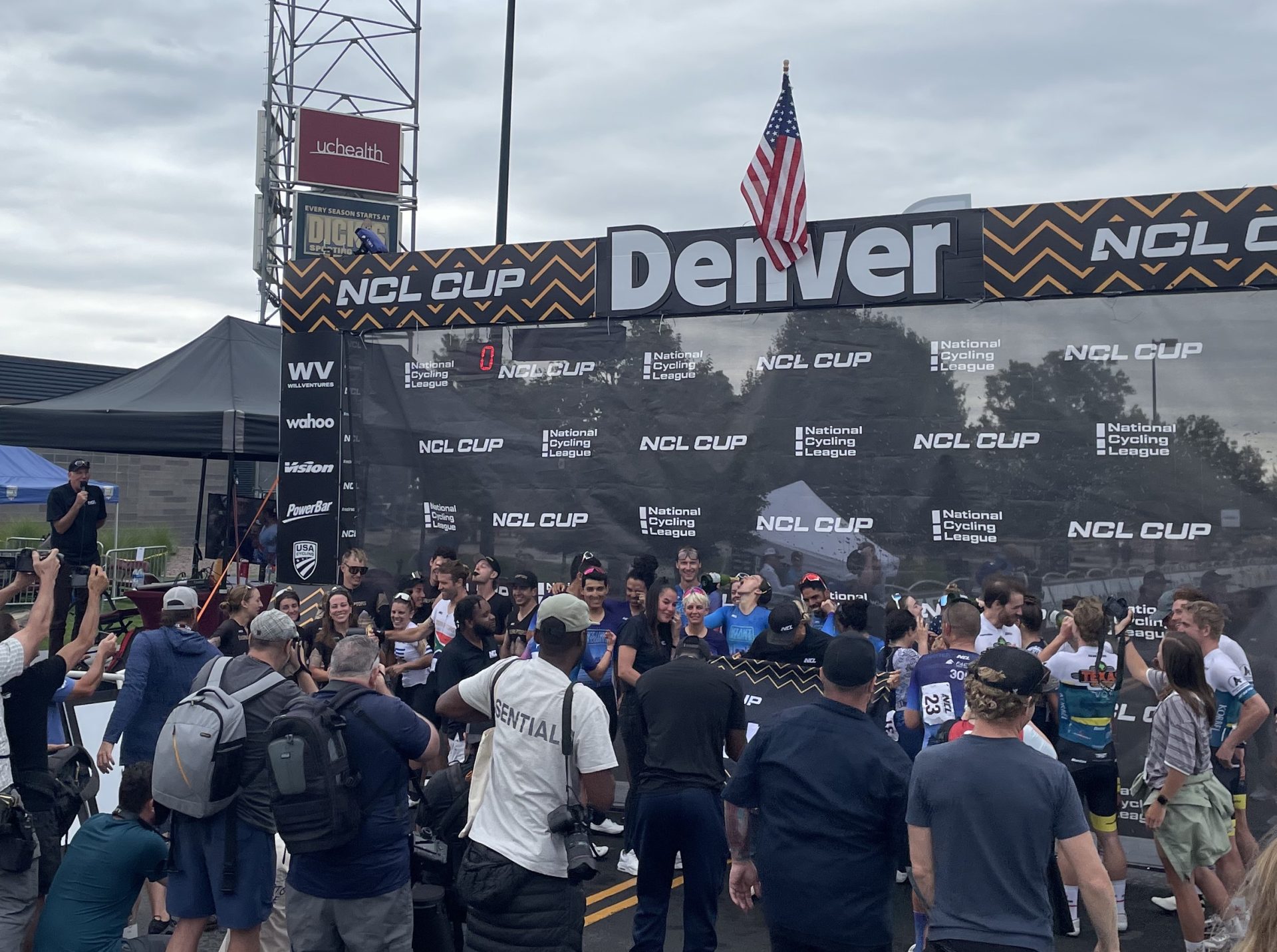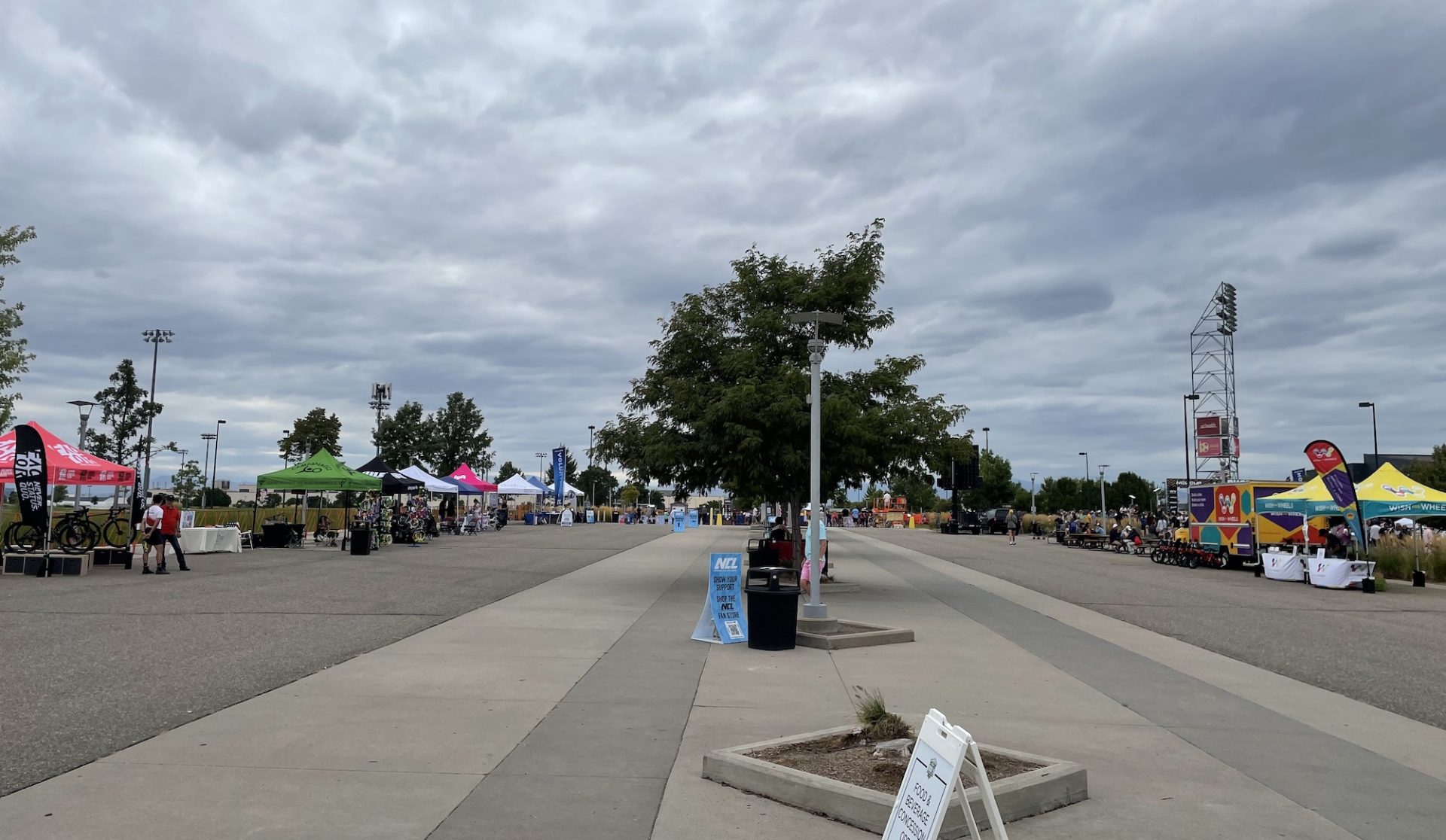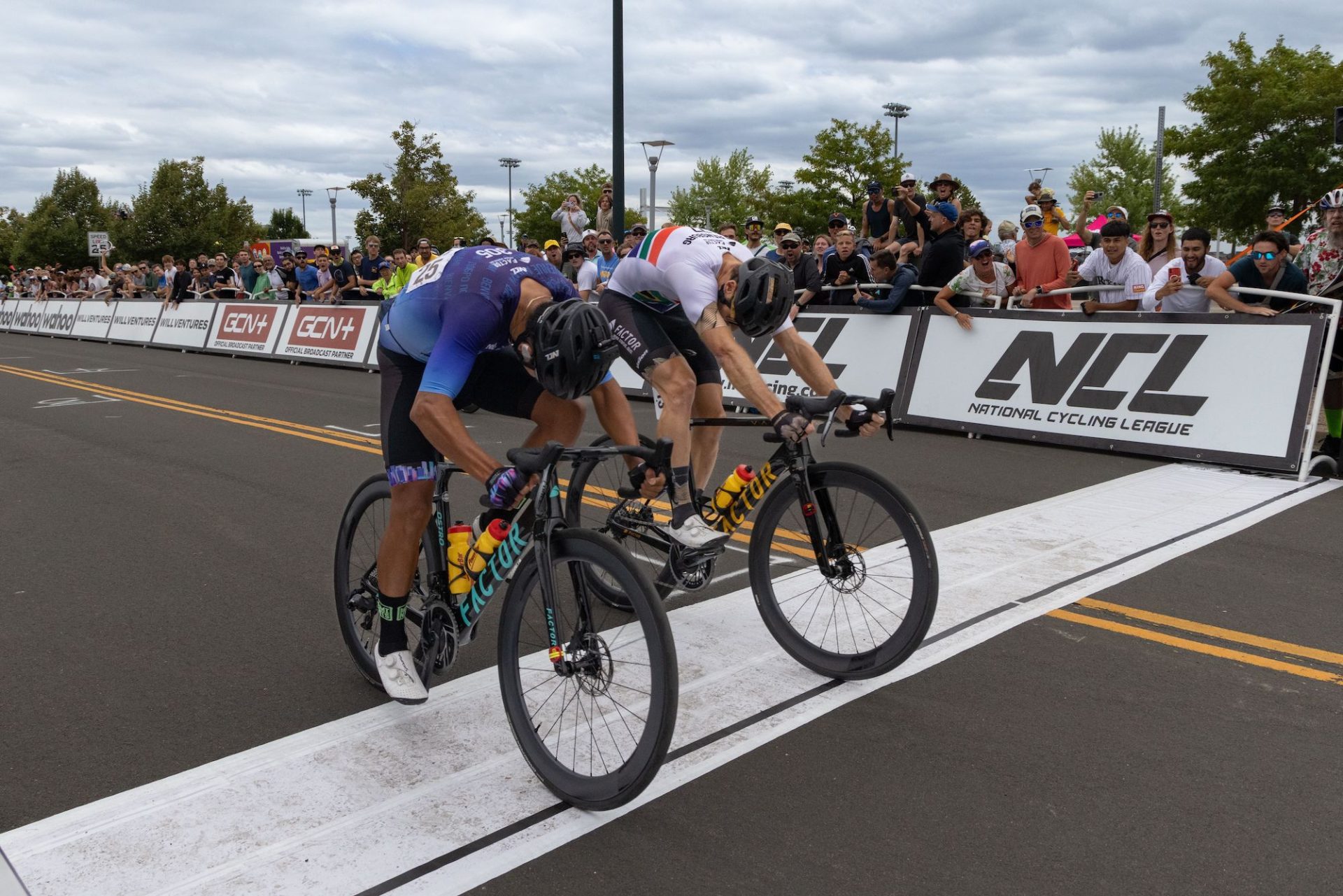The first bike race I’ve covered in person in a very long time felt familiar in many ways. When I parked in a huge lot in the suburban outskirts of Denver, Colorado, I was surrounded by vehicles adorned with the names of recognizable sponsors. As I started walking towards a simple but well-designed race course protected by barriers with plenty of staffers directing foot traffic, I heard the unmistakable sound of race announcer Dave Towle’s voice floating over a juniors race held in the run-up to the main event.
A big fan zone with tents and swag for brands that have been stalwart supporters of the sport for years abutted the finish line area, and a handful of people in USA Cycling attire were standing not far off. In short: I was surrounded by the trappings of a pro bike race in the United States, and at first glance, it didn’t feel especially different from so many other events I’ve attended.
But it was different, because this past Sunday, I wasn’t at just any old crit. I was at the National Cycling League Cup Race in Denver, just the second event in a series whose launch drew plenty of fanfare several months ago, largely due to the big money said to be involved ($7.5 million in seed funding) and the big names, like star athletes Jalen Ramsey of the NFL and Bradley Beal of the NBA, providing that money.
The initial news generated excitement but also skepticism. That was followed by various news items painting a picture of the NCL as very much in flux, with the proposed calendar shortened to just three races; personnel and logistical changes including a parting of ways with original organizational partner Medalist Sports; a second, mid-season funding round (this time featuring NBA great Kevin Durant); and generally vague communications.
How the project has developed as a business may be a story in and of itself, and in the absence of all that much actual bike racing, that narrative has been the one generally showing up in the headlines – but with the NCL in town, Sunday was a chance to tell a different story: What’s it actually like to watch an NCL Race?
It may be setting the bar really low here, but it’s notable that this brand-new operation – run and funded largely by people without strong ties to bike racing – still felt quite familiar to anyone who has been to a big crit on the US racing scene. Going to Commerce City outside of Denver, to the parking lot of the Dick’s Sporting Goods Arena where Major League Soccer’s Colorado Rapids play, did scratch the itch to watch bike racing in person.
On the other hand, the experience showed me that the folks at the NCL can and should improve in myriad ways if they want their project to take off in what seems to be an extremely difficult environment for bike racing in North America right now. On the bright side, one of the most basic impressions I had watching the NCL Cup race in Denver was, “This is actually kind of fun,” and at the end of the day, that’s something, and where the potential for long-term success lies.
What is the NCL, anyway?
Unless you’ve been following the NCL races already, you may need a quick explainer on what these events are all about. Basically, the NCL Cup is a series of events that showcase a new format of road racing in which teams race on circuits and accrue points when they pass the finish line on each lap; the highest point total at the finish wins. The main racing in each round happens on Sunday; Saturday night features qualifier races in a variety of formats, and which award a nominal number of points to the final score. Right now, there are three races total (the final round is August 19-20 in Atlanta), and you can stream them all on GCN+.
The victories are contested not by individuals but by whole teams, and each team has a women’s squad and a men’s squad that each do their own races as part of the event, creating a familiar halftime feeling. There are no existing bike-racing formats that allow perfect comparisons, but it has elements familiar from both the Madison and Points Race events from track racing, just on the road.
Teams can sub riders in and out of the action, a little like how the two-person teams in Madison work, except NCL teams feature four or five riders in the action at any given point (the format uses an auto-racing style pit for substitutions, so no mid-pack hand slings are needed). And like the Points Race, scoring is based on cumulative team points rather than individual or even team finish placings, which makes for a pretty novel experience.
The results of the race are therefore not “Paula Muñoz sprints to victory” but instead “the Miami Nights take the win ahead of the Denver Disruptors.”
That’s what happened on Sunday, where the men and women raced 25 laps each. Each lap features up to three points on offer, while on the final lap there’s a jackpot of 30 points to the team of the first rider across the line.

The men raced first in Denver. The Denver Disruptors and the men’s squad of the combined Texas Roadhouse-Goldman Sachs ETFs team accrued plenty of points in the early goings. Then, Miami’s Alfredo Rodríguez pipped Denver’s Reinardt Janse van Rensburg on the final lap for a huge chunk of points to put Miami ahead of Denver at the halfway mark, with Texas Roadhouse-Goldman Sachs the only other team in striking distance. Leah Kirchmann helped keep Denver in the mix in the ensuing women’s race, but in the end, Miami only extended their lead, partially thanks to Muñoz taking the final sprint.
After a lengthy break since the first race, in Miami in early April, where the Denver Disruptors topped the leaderboard, this time, the Miami Nights came to their rivals’ (nominal) home turf and triumphed.
Watching it in person or online felt like a combination of following a traditional bike race and watching a ball sport, where teams score points that are shown on a leaderboard. The rules are new and the points system has been tweaked since the Miami race, but all things considered, the format itself isn’t that hard to follow. More on that in a bit.
What didn’t work
There are plenty of areas in which this project needs to improve. Easily the most noticeable thing about the bike race on Sunday was just how few people were there in person. Four months after a Miami race that could reasonably claim to have been seen by 20,000 people thanks to its prime location in South Beach in Miami, attendance at the Denver race was … minimal. A huge chunk of the people there seemed to be friends or family of the racers themselves. To be honest, that’s not really surprising.
Compared to Miami, where literally thousands of people were walking by as the action unfolded, the suburban Denver location was not conducive in the slightest to drawing in any passing foot traffic because there just isn’t any foot traffic in this area. It’s a big sports complex that is great for hosting large crowds of people that come there intentionally from various parts of the Denver metro area, but nobody is just wandering by Dick’s Sporting Goods Stadium, which means that you need to generate buzz if you want anyone to show up, and that doesn’t seem to have happened here.

As a cycling enthusiast living in the area, I assume I’d be the target audience for any marketing that was being done around the event, and there wasn’t much to speak of. What’s more, information about the event even for those who sought it out was relatively vague. The web site said tickets (general admission, free through Eventbrite) were required. But on site, no tickets were actually checked or needed, except for the pay VIP section.
There wasn’t much signage visible outside of the immediate area of the race course, so getting into the heart of the action was only going to happen for those who knew about it already and put in the effort to find the race. With all that in mind, why would anyone have been out there on Sunday?
NCL’s VP of operations Reed McCalvin – who has decades of experience in bike racing, particularly the domestic scene – acknowledged that improving the event’s “ground game” of getting the word out locally was a major target moving forward. “We’ve been working with some of the clubs and stuff for a few months now and still, turnout wasn’t as great as I wanted it [to be] for the junior races,” McCalvin said. “It’s a year-round process and part of what we did with even naming the places after cities is to integrate ourselves in the communities, right? It’s so important to us.”
NCL co-founder Paris Wallace was not concerned about the Denver turnout, telling Escape Collective before the race started that his team was trying to use each event on this year’s circuit as a focal point for improving certain aspects of the product. After some technical issues marred the Miami livestream, the focus for Denver was to “nail the broadcast.” With that in mind, devoting more resources to the stream by saving on a venue well outside of Denver’s urban core seems to make sense, even if it meant far fewer in-person spectators.
For what it’s worth, the course in Denver (along with tweaks to the scoring system) did indeed make for a more-exciting race.
But with that focus on the broadcast, it’s not surprising that the in-person experience of the otherwise-interesting Denver race could have been improved in some pretty straightforward ways to maximize the excitement. In the NCL’s format, every lap counts, and that’s sort of the point: it’s not just a long day for a doomed breakaway followed by a catch and a sprint lasting a matter of moments. As such, spectators either need to be glued to the action all day and also doing mental math, or they need to be able to see a scoreboard, and that’s if they even understand the scoring system at all.
There was a large screen showing the broadcast near the finish line and another one by the pits, but for a format where it’s all about the teams scoring points, fans at the roadside need to be able to know the score basically at all times, and that means more visual cues than we got in Denver: more big screens, or at least some basic scoreboards. Some additional cues to help understand the format would have added value for spectators too.
Being able to hear the finish-line commentary would gone a long way to keep spectators informed of the situation as well. It was hard to hear announcer Dave Towle anywhere other than right at the finish line given the limited sound setup on the day, and that’s saying something. Towle is pretty darn good at projecting into a microphone, as anyone who has ever stood near the finish line of an American bike race can attest.
As it was, I had to constantly walk over to the one nearby broadcast screen (or check the GCN app on my phone) to keep track of the score. To be fair, I’ve been to plenty of big-time European races without any nearby screens whatsoever, but still, it wasn’t ideal. On the bright side, the people running the show at the NCL know how important this aspect of the experience is, as I’ll explain in a moment.
To recap: There were very, very few people at the Denver NCL Cup, and those of us that were there had to make a bit of an effort to keep up with what was going on in the race because the audiovisual elements of the whole production on the ground were not perfect and the scoring system is still so new.
An exciting race, once you figure out the format
All that said, I did make some effort to follow what was going on, and in so doing, I was rewarded.
When all was said and done, I was entertained in ways that felt pleasantly familiar, both as a bike racing fan and more generally as a fan of other sports that your non-cycling friends follow too. To put it another way: On Sunday morning, the soccer team I follow, Liverpool FC, drew 1-1 with Chelsea in the Premier League season opener. Then my beloved Philadelphia Phillies baseball team lost a frustrating game to the Minnesota Twins. To close out the day, the visiting Miami Nights beat my hometown Denver Disruptors, but at least I got to watch some good racing (with some big names) in person.
Doesn’t that almost sound like something that might make sense even to your non-cycling friends?
Once I’d digested the scoring system, the format was quite straightforward and it was easy to understand how Denver and Texas Roadhouse were thriving with riders off the front grabbing points every lap over the course of a half hour or so, but with the constant threat of the Miami Nights making a big jump in the standings in the final sprint.
Toward the end of the men’s race, I headed over to the pits, where Janse van Rensburg, one of the biggest names in the race, was recovering after having been subbed out and was about to head back in for the finale. If that concept sounds weird for a bike race, it’s because it is – but hey, why not give a unique idea a try if you’re going to whip up a brand-new format?
The pit area had a motorsport vibe to it, which I thought was a real treat. Former WorldTour pro Svein Tuft is now the sports director for the Denver Disruptors, and he looked as much like a NASCAR crew chief in the pits as a DS. When riders came in to pit, sports directors could get a better idea of how the team was feeling in the actual race than they otherwise might over the radio.
After subbing back in, Janse van Rensburg went on to get pipped in an extremely tight sprint by Miami’s fastest finisher, and thus the men’s race, even for all its newfangled rules, concluded with a thrilling and impactful finale that still felt very much like a bike race in the end, with Miami surging into the lead.
Then it was on to the women’s event, which played out similarly as the Denver Disruptors and the Goldman Sachs ETFs squad again tried to rack up points with attacks in an effort to stave off Miami’s fast finishers. That kept the overall title in play for the final sprint, but again, Miami was not going to be denied and ultimately ran away with the thing.
Regardless of the atmosphere on the ground, the race itself was entertaining. Riders I spoke to described it as demanding near-constant efforts, and that means that we as spectators got to watch people on the rivet most of the times they speed by. That was borne out in the numbers on Sunday: Serghei Tvetcov, who rides for the Disruptors but was not racing in Denver on Sunday, told Escape Collective that there was a difference of nearly 100 watts between the average power and normalized power of his teammate Noah Granigan on the day. In other words, the repeated surges that Granigan was doing were pretty intense.
As Kirchmann put it, the NCL races are “quite hard because you’re really sprinting every single lap, so you can never really rest during the race compared to a normal crit where you’re trying to save as much as possible for the final.” The only way to really recover (slightly) is to sub out.
An interminable 220 km flat Tour de France stage this is not.
Sebastian Alexandre, the veteran ex-pro and DS of the Miami Nights, and Miami racer Clever Rodríguez both used the word “dynamic” to describe the racing experience, and it’s a word that fits. Unlike in a traditional road race, where there is often a lengthy lull in the action between the initial fight for the break and the race finale, each lap of an NCL Cup race really matters, and that means that there are always opportunities for riders to make an impact in a variety of ways.
What is the NCL’s future?
All told – and combined with the fact that the racing featured names longtime bike-racing fans have actually heard of like Janse van Rensburg, Kirchmann, and Sergio Henao – it made for a reasonably engaging show in person even with some of my aforementioned gripes. What’s more, if you were watching on GCN+, you were treated to most of the good without much of the bad. There was entertaining drone footage that followed riders sprinting down the finishing straight and a very easy-to-follow sidebar showing the score and the number of laps left to go, just like you might see watching any other sporting event.
For the folks running the NCL, that’s precisely the point. McCalvin told Escape Collective that one of Wallace’s central ideas for everything they’re doing is that “a sport is good and can be enjoyed by people across the world if you go to a bar and the sound isn’t on, and you look up at a TV screen and you can figure out what’s happening.”
Whether or not you could figure out what was happening on the ground at the race in Denver was up for debate, but it was indeed pretty darn simple to follow the race on GCN+, and yet it was still a bike race at heart.
The fact that Wallace and McCalvin kept coming back to their commitment to continually learning from each event the put on was a reason to be optimistic about this project – if their investors feel the same way and have the patience to let it develop. Even if they’ve come up with a cool concept, as the crowd numbers showed on Sunday, they have a long way to go to turn this into a series that will survive long-term.
At least for now, Wallace is characterizing things in a way that sounds like his team is in it for the long haul, which is a good sign. “The in-person and the marketing and stuff we’re doing this year is for our 2025 event, because it takes a while to really create a movement,” Wallace said. Assuming his investors are giving him the runway to make that a viable goal, it sounds like a reasonable approach.
The upcoming race in Atlanta will be another opportunity for the series to show potential fans that it’s worth their time – but most of those fans will need to be watching online, as the in-person experience will be a VIP-tickets-only affair. There’s nothing wrong with that for a sporting event. Tickets-only is how most other sports work, after all, although the advertised price – $150 a pop – is a tall order for a bike race. For Atlanta especially, the digital product will need to be good.
All things considered, the NCL put on a decent show in Denver. Atlanta will be the last broadcast of the year for a series that, ultimately, only ran for three races this season, so hopefully it will leave a good impression on anyone tuning in. I left the Denver race thinking that the core product, a relatively fresh take on bike racing, could actually be worth supporting, but it is the fans who will ultimately be the judge of that.
What did you think of this story?

